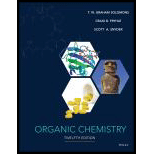
Concept explainers
Interpretation:
The number of protons and neutrons in the isotopes of nitrogen is to be determined.
Concept introduction:
Isotopes are the two or more atoms that have same number of protons but different number of neutrons.
In the periodic table,
Mass number is the sum of number of neurons and number of protons present in the nucleus of the atom. Mass number is represented by A. Mathematically, mass number is calculated as:
Here, A is the
Answer to Problem 1PP
Solution:
Explanation of Solution
The atomic number (Z) from the symbol for nitrogen is
The number of protons is same as the atomic number. So, the numbers of protons for both the isotopes of nitrogen are 7.
The total number of protons and neutrons is equal to the atomic mass. Therefore, the number of neutrons is calculated as follows:
Rearrange the above equation:
Here, A is the atomic mass of the element.
For
For
For
For
Want to see more full solutions like this?
Chapter 1 Solutions
EBK ORGANIC CHEMISTRY
- I'm having trouble with converting lewis diagrams into VSEPR diagrams. I currently have this example of C2BrCl3 which I want to turn into a lewis structure, but I'm not sure what steps I need to do in order to do so. I have the table written down, however, there's two central atoms so what would I do? There seems to be 4 electron domains on the carbon atom and no lone pairs so it would seem like this shape would be tetrahedral. Here's what I have now. Thanks!arrow_forwardWe discussed the solid phase resin using in peptide synthesis. Provide a mechanism, for its formation. DRAW THE MECHANISM.arrow_forwardPlease help. Every time I've asked an expert in the past, it's been wrong :(arrow_forward
- Please help everysingle time ive asked in the past, the solution has been wrongarrow_forwardPlease helparrow_forward(a) 21.8 Name the following compounds. & (b) Br (e) O₂N. (h) H (c) Br (d) NH2 ☑N Br H ہیں Ph (g) OMe бл .0-0.e 21.9 Draw a structural formula for each compound. (a) 2,3-Dinitrotoluene (c) Diphenylmethanol (e) p-Nitroaniline (b) 3-Propylanisole (d) m-Propylphenol (f) Pentabromobenzenearrow_forward
 Introduction to General, Organic and BiochemistryChemistryISBN:9781285869759Author:Frederick A. Bettelheim, William H. Brown, Mary K. Campbell, Shawn O. Farrell, Omar TorresPublisher:Cengage Learning
Introduction to General, Organic and BiochemistryChemistryISBN:9781285869759Author:Frederick A. Bettelheim, William H. Brown, Mary K. Campbell, Shawn O. Farrell, Omar TorresPublisher:Cengage Learning
